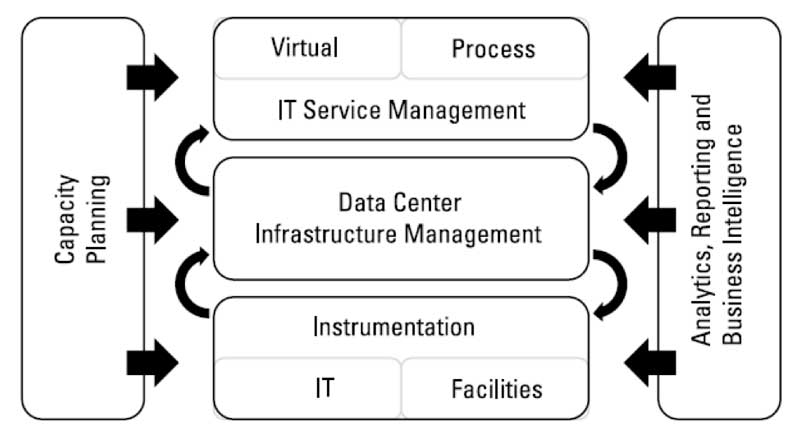For many enterprises, IT infrastructure keeps growing more complex with more systems, distributed infrastructure and more technology. This complexity begs for a simple yet robust observability and management tools. Organizations are increasingly turning to Data Center Infrastructure Management (DCIM) to make it easier to manage across hybrid multi-cloud infrastructure.
What is DCIM?
DCIM is a resource- and capacity-planning solution for data centers from the business perspective. An intelligently deployed DCIM extends its benefits far beyond IT into all business systems by taking into account the complexity, costs, value and ROI of core business assets and facilities over their life cycles.
Editor’s note: Learn about Nutanix Prism, an enterprise-grade control and management plane for unified hybrid multicloud management.
While DCIM solutions were first launched over a decade ago, they initially focused only on monitoring, such as power usage and cooling, wrote Assaf Skolnik, CEO of RiT Tech, in his article The resurgence of DCIM: Navigating the future of data center management. He pointed to the limited scope, departmental silos and lack of integration as the reasons for slow adoption.
“In recent years, however, DCIM has undergone a significant transformation and continues to evolve to the level where Gartner now has DCIM back on the agenda. Today DCIM solutions are far more comprehensive, seamlessly integrating with other operational management tools such as BMS, CMDB, ITSM, CRM, or BPM – Business Process Management tools to provide a holistic view of data center operations,” wrote Skolnik.
Rob Stevenson, founder of BackupVault, who has integrated DCIM tools to improve visibility, optimize performance and streamline resource management for diverse infrastructure, stresses the importance of adopting DCIM early in the infrastructure life cycle.
“Waiting until operations become complex often results in inefficiencies that are harder to resolve. Also, DCIM isn’t a one-size-fits-all solution,” said Stevenson.
“Businesses should carefully evaluate their specific needs and choose tools that align with their goals, especially as the technology continues to evolve with AI, cloud-native applications, and sustainability initiatives in mind.”
However, simply purchasing DCIM technology does not bring the expected benefits. Organizations must build a modern, software-controlled data center designed to collect and analyze humongous amounts of data, constantly consolidate and improve workflows, and make optimum use of IT equipment and resources. Businesses also need to use real-time data to facilitate smarter and quicker decisions, reduce operational risks and provide instant services and solutions to their customers. By carefully considering all facets and building a DCIM-based data center with the goals in mind, organizations see the best results.

Image source: Nlyte Software
Here are three considerations when considering moving to a DCIM data center:
Key 1: Focus on using DCIM for energy management
In recent years, businesses have been increasingly prioritizing sustainability, which the Honeywell Environmental Sustainability Index found was the topmost important corporate initiative (75%) for organizations. However, the Improving Sustainability in Data Centers Report found that data centers account for approximately 2% of all energy consumption worldwide. Furthermore, using AI in the data center requires additional energy consumption, which increases the environmental impact of the data center.
Organizations are increasingly turning to DCIM as part of their sustainability initiatives. Stevenson says he’s seen DCIM reduce costs significantly in data centers by identifying underutilized resources and enabling precise cooling strategies. For example, DCIM tools are increasingly designed to monitor and reduce carbon footprints, aligning with global sustainability goals, he says.
DCIM can help with equipment management. Overheating servers and consequent overcooling use more resources, reduce performance, increase risks and decrease the hardware lifespan. Modern DCIM solutions save costs throughout the operational duration of equipment, using intelligent PDUs with sensors for temperature, humidity, airflow, pressure, water, smoke and motion. The human element to monitoring is added by connecting to CCTV or webcams.
SDCIM software also has the ability to monitor the energy usage of individual servers and intelligent racks. Dashboards can show power utilization trends per device or system and alert managers when thresholds are crossed. An AI-based DCIM might have the capability to forecast usage and even balance power loads based on current consumption. This ensures budgets are not used up by inefficiencies or stresses in one or more workloads.
Key 2: Integrate DCIM with AI
While AI is driving the need for organizations to increasingly use DCIM, the technology also plays a key role in transforming the data centers to meet the changing needs. Stevenson says that DCIM and AI are a perfect complement because all workloads are dynamic, often requiring rapid scaling and precise resource allocation.
“DCIM provides the insights needed to allocate resources efficiently, ensuring optimal performance for these demanding applications,” said Stevenson.
“For instance, AI models can benefit from DCIM’s ability to predict hardware failures, avoiding interruptions and maintaining smooth operations.”
Skolnik pointed to the ability to provide real-time monitoring and analytics as one of the most significant modern DCIM advancements.
“This allows data center operators to monitor critical metrics such as power usage, temperature, and resource utilization in real-time, resulting in the ability to identify and address any issues before escalation into a major problem. Therefore, reducing costly downtime and maintaining optimal data center performance,” wrote Skolnik.
Key 3: Implement change management with hyperconvergence and hybrid cloud
Data center operations are more complex than ever, with workflows and applications being added, stopped, modified or repurposed at any given moment according to evolving business demands. It’s important for IT managers to identify and manage the workflows that have the potential to change the data center’s physical and virtual assets and then control infrastructure changes accordingly while maintaining efficiencies.
Stevenson sees many organizations struggling with hybrid multi-cloud setups, which spread resources, data and applications across multiple platforms, making visibility and control a daunting task. He says that this is where DCIM steps in.
“DCIM acts as a centralized solution, offering real-time insights into your infrastructure, whether it’s on-premises, in the cloud, or a mix of both,” said Stevenson.
“For businesses leveraging cloud-native and AI applications, this visibility is crucial. These workloads are dynamic, often requiring rapid scaling or precise placement to optimize performance and costs.”
A full-fledged DCIM solution features intelligent tools for workflow automation that integrate with the enterprise cloud’s single-pane-of-glass interface. Managers can use the centralized interface to generate change requests, automate device moves, respond to security issues and maintain audit trails of requests and compliance tasks.
More automation and AI integration ahead
While DCIM is not a new technology, the industry’s increased use of it has simply touched the tip of the iceberg. Stevenson predicts that DCIM will increase its use of automation and deep integration with AI. He also expects the DCIM data center in the near future that DCIM solutions will move from monitoring to even more actively managing and adapting to the infrastructure in real time.
“DCIM isn’t just about control; it’s about empowering businesses to adapt to modern demands with confidence and efficiency, bridging the gap between traditional infrastructure and cutting-edge technology,” said Stevenson.
IT Agility Leads to Business Continuity
Good data center infrastructure management is a catalyst for innovation and tighter integration of business functions. The everyday, real-time operational benefits are seemingly endless – more workplace mobility and better collaboration facilities for staff, higher availability and scalability of workloads, faster recovery from security incidents, and lower TCO due to optimal use of software, hardware, and virtual resources.
“In many cases, I&O leaders can simplify their infrastructure without significant additional capex or opex investment,” stated Phil Dawson, VP of Research at Gartner in a 2017 report.
“This creates a stronger platform to move forward and invest wisely to position IT at the heart of business growth.”
The DCIM interface the organization uses often becomes the central, trusted source and conduit of mission-critical information within the organization. It enables CIOs and CTOs to track usage patterns for a variety of applications and change business processes accordingly. The data collected can be used as baselines for forecasting in the business’s revenue models. All said and done, data center infrastructure management lies at the core of data-driven digital transformation in the enterprise.
This is an updated version of the article first published on June 3, 2020.
Dipti Parmar is a contributing writer. She writes for major tech and business publications such as CIO.com, CMO.com, Entrepreneur and Inc. magazines. Follow her on Twitter @dipTparmar.
© 2025 Nutanix, Inc. All rights reserved. For additional information and important legal disclaimers, please go here.










